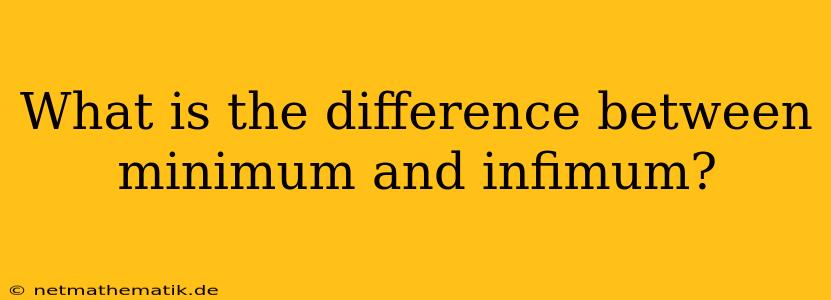In the realm of mathematics, particularly in the study of sets and order relations, the concepts of minimum and infimum play crucial roles. While they share a certain degree of similarity, they are distinct and possess subtle yet significant differences that are essential to grasp for a thorough understanding of mathematical concepts. This article delves into the nuances of these terms, exploring their definitions, providing illustrative examples, and clarifying their implications.
Understanding Minimum and Infimum
The concepts of minimum and infimum are closely related to the notion of bounds in a set with respect to a specific ordering. A bound, in this context, is a value that either limits the set from above or below. Let's consider a set S of real numbers and a specific ordering, for instance, the usual less than or equal to relation (≤).
Minimum: The Smallest Element
The minimum of a set S, denoted as min(S), is the smallest element within the set. This means that every element in S is greater than or equal to the minimum. Formally, if m is the minimum of S, then for any element x in S, x ≥ m. It's important to note that a set may not always have a minimum.
Example:
Consider the set S = {2, 4, 6, 8}. The minimum of this set is 2, as it is the smallest element among all the elements in S.
Infimum: The Greatest Lower Bound
The infimum of a set S, denoted as inf(S), is the greatest lower bound of the set. This means that the infimum is a value that is less than or equal to every element in S, and there is no greater lower bound than the infimum. Formally, if i is the infimum of S, then for any element x in S, x ≥ i, and if y > i, then there exists an element x in S such that x < y.
Example:
Consider the set S = {1/2, 1/4, 1/8, ...}. This set represents an infinite sequence where each term is half of the previous one. The infimum of this set is 0.
- Lower bound: 0 is a lower bound for S because every element in S is greater than or equal to 0.
- Greatest lower bound: There is no larger value than 0 that can also be a lower bound for S. For any value greater than 0, we can find a term in the sequence that is smaller than it.
Key Differences Between Minimum and Infimum
- Membership: The minimum must be an element of the set S. In contrast, the infimum may or may not be an element of the set S.
- Existence: A set may not have a minimum if it is unbounded below or if it contains infinitely many elements that are arbitrarily close to a lower bound. However, every non-empty set of real numbers that is bounded below has an infimum.
- Uniqueness: If a set has a minimum, it is unique. Similarly, if a set has an infimum, it is also unique.
Applications of Minimum and Infimum
These concepts have wide applications in various areas of mathematics and related fields:
- Optimization: Finding the minimum or infimum of a function is a central problem in optimization theory, where we seek to minimize or maximize a given function.
- Calculus: The infimum and supremum (the maximum value) of a function are used in defining continuity, differentiability, and integrability.
- Topology: The concepts of infimum and supremum are fundamental in defining topological structures, such as metric spaces and topological groups.
- Computer Science: In computer science, algorithms for searching and sorting often rely on the concepts of minimum and maximum values.
Conclusion
The concepts of minimum and infimum are essential tools in mathematics, providing a framework for understanding the behavior of sets and functions with respect to bounds. While they are related, their differences are subtle but crucial. The minimum is the smallest element in a set, while the infimum is the greatest lower bound. The minimum must be an element of the set, while the infimum might not be. However, both concepts are important for understanding and analyzing mathematical structures and are fundamental for various applications in diverse fields.
